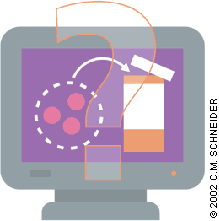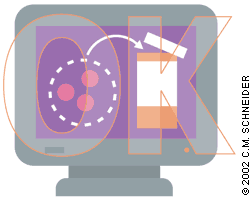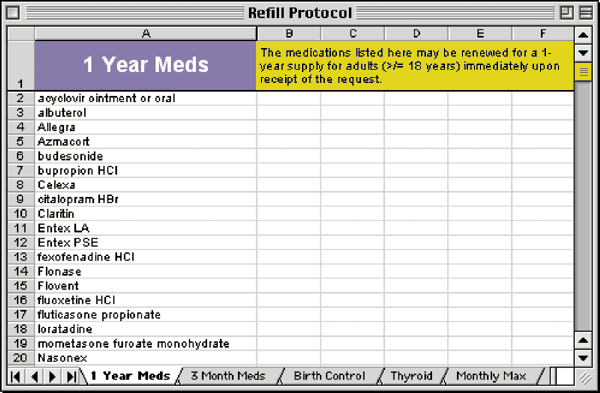
Here’s an easy way to improve service, decrease errors, facilitate compliance and go home earlier.
Fam Pract Manag. 2002;9(9):55-56

Necessity is the mother of invention. Last year, I moved my practice to a new group practice founded by my associates and myself while we simultaneously implemented an electronic medical record (EMR) system. My days were so full I could hardly breathe, and every night I faced a huge volume of routine medication refills. Reviewing and okaying these requests was requiring over an hour of my time. Acting out of necessity, Yoli, a medical assistant who had worked with me for years in my previous practice, started sending me chart messages to the effect of “Patient John Doe needed a refill of Zovirax [acyclovir]. I okayed it times 3. I hope that’s all right.” As I was just getting to the messages at 9 o’clock that night, it was more than all right – it was brilliant. She had worked with me long enough to know which medications I would OK over the phone and which would require a visit. It occurred to me: If she could do a decent job at guessing the unwritten rules I was using when I reviewed refill requests, I should be able to write down these rules and teach the rest of the staff to use them too.
The fear of delegation
The main obstacle to my creating a refill protocol that my staff could use to handle refill requests independently was my own fear. I had been trained to believe that being a good doctor meant being thorough, meticulous and detailed (i.e., a control freak). How could I delegate such an important job? And how could the staff possibly understand which medications could be refilled under which circumstances? For example, if I put Neurontin (gabapentin) as OK for my staff to refill, thinking of chronic neuropathy patients, I might find my patient with a seizure disorder and bipolar disease using her medication at an improper rate. In cases such as this, medication refills would have to remain under my direct supervision; however, a large number of medications could be dealt with easily by an automatic refill protocol. After all, I did not need to review the chart personally each time a patient requested a refill for nasal steroids, since they have a very low risk for side effects and interactions.

The benefits of using a refill protocol were striking. It would improve patient service, decrease errors associated with delays in treatment, facilitate patient compliance and save my office staff time. Patients had always complained that the 24- to 48-hour turnaround on refill requests was a problem, even though it seemed perfectly reasonable to me, the doctor who takes no medication on a regular basis. I could easily recall several cases where delays in approving refill requests adversely affected patient compliance and patient health (e.g., it took 24 hours for a patient to get an albuterol refill, and by that time, the patient was in the ER for a nebulizer treatment). We were also creating obvious rework for ourselves with patients calling a second or a third time for refills due to our slow response. If I could safely empower my staff, they could use our EMR to access any patient’s chart and handle the majority of refill requests immediately upon receipt of the request. No messages back and forth. No call backs to the pharmacy.
Designing a solution
To make the system work, I needed a protocol or list of medications approved for refill that would be easy for my staff to use and easy for me to update. I needed to provide generic names and trade names so staff members could find the drug in question easily. I needed to keep the system as simple as possible and avoid including medications with disparate uses that are harmless in one indication or dose but dangerous at another, such as tacrolimus.
Consulting the monthly Prescriber’s Letter, I started making a list of medications in Microsoft Excel, assigning different work sheets for different categories of medications and sorting them alphabetically. (You can view and download our current working version of the protocol in the box below.) The first work sheet is labeled “1 Year Meds” and lists medications that are OK to refill for up to one year from the patient’s last exam (e.g., nasal steroids, selective serotonin reuptake inhibitors, herpes medications, nonsedating antihistamines). The second work sheet is labeled “3 Month Meds.” It has a long list of antihypertensive medications and diabetic medications and states that as long as the patient has been seen within the last three months, it is OK to refill for another three months. The third work sheet is labeled “Birth Control” and provides a list of contraceptive medications, as well as hormone replacement agents. Our staff is empowered to approve these refill requests for one year after the patient’s most recent well-woman exam or Pap smear. If the patient is overdue for an exam, she is called to schedule one and we OK only enough medications to last her until that appointment. The fourth work sheet is labeled “Thyroid.” It lists thyroid replacement medications that can be refilled for up to one year after a thyroid-stimulating-hormone test documented to be in the reference range. (I do not generally prescribe thyroid suppression. Physicians who do would need to be careful about automating these refills.) The final work sheet is labeled “Monthly Max” and lists the maximum number of refills allowed per month for certain medications. It empowers my staff to refill medications such as Diflucan (fluconazole) as long as the patient has not received the maximum amount in the previous 30 days.
The tabs of each work sheet make it easy for my staff, who have already become Excel proficient with other projects, to select the protocol they want to consult. If the medication list becomes too long, they can use the “Find” feature to locate a drug on the list more quickly. As a precautionary measure, the file can be saved as “Read only” to prevent staff members from inadvertently altering the file while using it.
A REFILL PROTOCOL
By creating a list of approved medications, shown here, the author has safely empowered her staff to refill certain medications independently upon the patient’s request. To download and view the protocol in its entirety, click below.

Beyond the protocol
While the refill protocol is an effective tool for empowering staff to handle refill requests safely, our practice has taken additional measures to improve care, service and efficiency. As our office has reached true “open access” (that is, we offer every patient a same-day appointment when they call our office) and as we have begun using our EMR to generate ticklers (rather than using patients’ refill requests as our reminder system), we have gradually had to rely on our refill protocol less and less. When we see patients, we routinely write prescriptions for a year at a time and use our tickler file to track follow-up care. Together, these changes have produced a more efficient and effective medical practice – and a less-harried and more rewarding workday for my colleagues and myself.